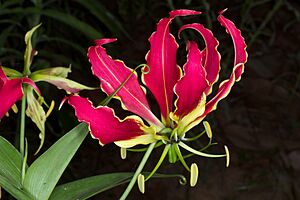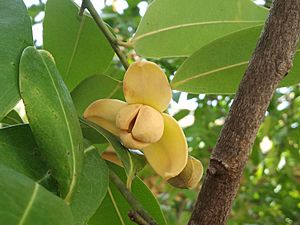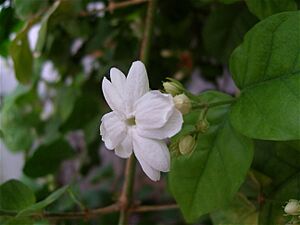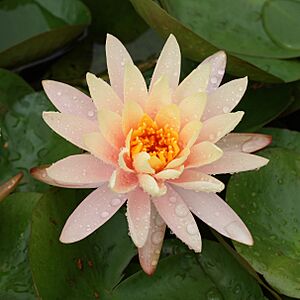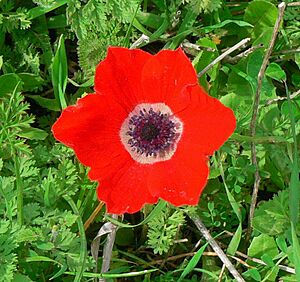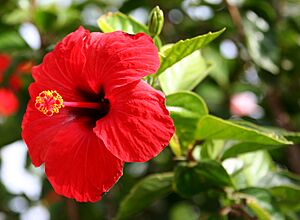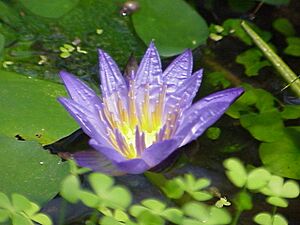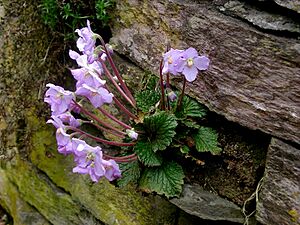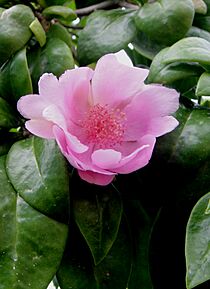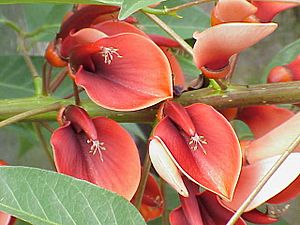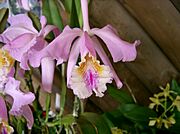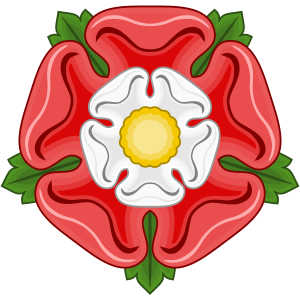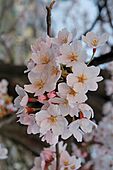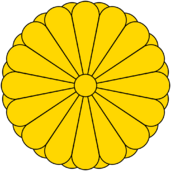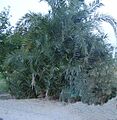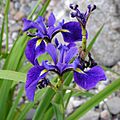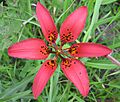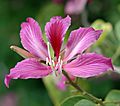List of national flowers facts for kids
Plants are often chosen as special symbols for countries or regions. These symbols are called floral emblems or national flowers. They can be picked by governments or by public votes. Australia and Canada often use the term 'floral emblem,' while the United States usually says 'state flower.'
Contents
National Flowers Around the World
Africa
Mauritius
The national flower of Mauritius is Ruizia boutoniana.
Nigeria
The national flower of Nigeria is Costus spectabilis, also known as Yellow Trumpet.
Seychelles
The national flower of the Seychelles is the tropicbird orchid (orkid payanke), which is Angraecum eburneum.
South Africa
The national flower of South Africa is the King Protea, Protea cynaroides.
Tunisia
The national flower of Tunisia is jasmine. It became a symbol for the 2010 Tunisian Revolution.
Zimbabwe
The national flower of Zimbabwe is the flame lily, Gloriosa superba.
Asia
Afghanistan
The national flower of Afghanistan is the Tulip. It is called Lala in Farsi and Khatol in Pashto.
Bangladesh
The national flower of Bangladesh is the water lily Nymphaea nouchali. It is called Shapla in Bengali.
Bhutan
The national flower of Bhutan is the blue poppy. For a long time, people thought it was Meconopsis grandis. But in 2017, it was identified as a new species, Meconopsis gakyidiana.
Brunei
The national flower of Brunei is Simpoh Ayer (Dillenia suffruticosa).
Cambodia
Cambodia officially chose the romduol (Khmer: រំដួល) as its national flower in 2005. Its scientific name is Sphaerocoryne affinis.
Hong Kong
The symbolic flower of Hong Kong is the Hong Kong orchid tree ("洋紫荊"), Bauhinia blakeana.
Indonesia
Indonesia has three types of floral emblems:
- The puspa bangsa ("national flower") is melati (Jasminum sambac).
- The puspa pesona ("flower of charm") is anggrek bulan or moon orchid (Phalaenopsis amabilis).
- The puspa langka ("rare flower") is padma raksasa rafflesia (Rafflesia arnoldii).
These were chosen on World Environment Day in 1990. Melati (Jasminum sambac) is a small white flower with a sweet smell. It is seen as a sacred flower in Indonesian tradition. It stands for purity, sacredness, and sincerity. For example, brides often wear jasmine in their hair on their wedding day.
Each of the 34 provinces of Indonesia also has its own provincial flower.
Iran
The national flower of Iran is the water lily, also called nymphaea (Niloofare Abi in Persian). This flower has been Iran's national flower since the Achaemenid Empire era (552 BC).
Israel
The national flower of Israel is the poppy anemone (Anemone coronaria). It was chosen in 2013, replacing Cyclamen persicum.
Japan
The national flower of Japan is the Sakura blossom, also known as the cherry blossom.
Jordan
The national flower of Jordan is the Black iris (Iris nigricans).
Laos
The national flower of Laos is the plumeria (champa).
Malaysia
The national flower of Malaysia is the bunga raya (Chinese hibiscus, Hibiscus rosa-sinensis).
Maldives
The national flower of the Maldives is the pink polyantha rose (Rosa polyantha), called fiyaathoshi finifenmaa.
Mongolia
The national flower of Mongolia is Scabiosa comosa (Mongolian: бэр цэцэг, ber tsetseg).
Myanmar
The national flower of Myanmar is Pterocarpus indicus (paduak).
Nepal
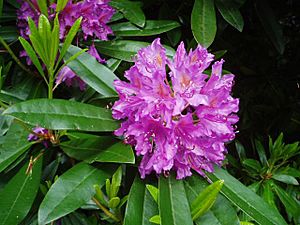
The national flower of Nepal is the tree rhododendron (Rhododendron arboreum).
North Korea
The national flower of North Korea is the Korean mountain magnolia (Magnolia sieboldii, Korean: 목란/木蘭 mongnan).
Pakistan
The national flower of Pakistan is common jasmine, also known as Jasminum officinale.
Philippines
The Philippines chose the sampaguita (Arabian jasmine, Jasminum sambac) as its national flower in 1934. It symbolizes purity and cleanliness because of its white color and sweet smell. People often make garlands from it for visitors and important guests.
Saudi Arabia
The national flower of Saudi Arabia is Taif’s Rose (Rosa × damascena).
Singapore
The national flower of Singapore is a special orchid called the Singapore orchid or Vanda Miss Joaquim (Papilionanthe teres × Papilionanthe hookeriana).
South Korea
The national flower of South Korea is Hibiscus syriacus. In South Korea, it is called mugunghwa (Korean: 무궁화). This flower's name means "eternity" or "endless abundance." It has been linked to Korean culture for many centuries.
Sri Lanka
The national flower of Sri Lanka is Nil mānel (නිල් මානෙල්), the blue-star water-lily (Nymphaea stellata). This beautiful water flower appears in old Sri Lankan art and stories.
Taiwan
The national flower of the Republic of China (Taiwan) was officially named the plum blossom on July 21, 1964. The plum blossom, called meihua (Chinese: 梅花; pinyin: méihuā), stands for strength and never giving up. This is because plum trees bloom even in harsh winters.
Thailand
The national flower of Thailand is the Golden Shower Tree (Cassia fistula). It is known locally as dok khuen or rachapruek.
Vietnam

The national flower of Vietnam is the lotus flower (Nelumbo nucifera).
Europe
Andorra
The national flower of Andorra is Narcissus poeticus.
Austria
The national flower of Austria is edelweiss (Leontopodium nivale).
Belgium
- Brussels – Iris pseudacorus
- Flanders – poppy
- Wallonia – Gaillardia
Bulgaria
The national flower of Bulgaria is the rose.
Croatia
The unofficial national flower of Croatia is Iris croatica.
Cyprus
The national flower of Cyprus is Cyclamen cyprium.
Czech Republic
The national flower of the Czech Republic is Tilia.
Denmark
The national flower of Denmark is the daisy. This is usually either the marguerite daisy (Argyranthemum frutescens) or the oxeye daisy (Leucanthemum vulgare). The oxeye daisy grows naturally in Denmark.
Estonia
The national flower of Estonia is the cornflower.
Finland
The national flower of Finland is the lily of the valley.
France
The national flower of France is Iris sibirica.
Guernsey
The national flower of Guernsey is Nerine sarniensis.
Iceland
The national flower of Iceland is the White dryad (Dryas octopetala).
Lithuania
The national flower of Lithuania is Ruta graveolens.
Netherlands
Many people think the tulip is the national flower of the Netherlands. However, the actual national flower is the daisy (Bellis perennis). It was chosen in a public vote in 2023.
Poland
- Poland – red poppy
- Kashubia region – Kashubian vetch
Portugal
Portugal does not have an official national flower. However, lavender is often mentioned. The carnation (Dianthus caryophyllus) is also a symbol of the country's victory against a past dictatorship. This event is known as the Carnation Revolution.
Romania
The national flower of Romania is the peony.
Russia
The national flower of Russia is the chamomile.
Serbia
The national flower of Serbia is Natalie's ramonda (Ramonda nathaliae). It symbolizes Serbia's fight and victory in World War I. People wear artificial Natalie's ramonda flowers to remember soldiers who died in the war.
Slovakia
The national flower of Slovakia is Tilia.
Slovenia
The national flower of Slovenia is a carnation. It is often seen at important life events like christenings and weddings. White carnations represent happiness. Red carnations have different meanings, including love and revolution. People also throw red carnations into graves at funerals.
Carnations are often embroidered on tablecloths and clothes. They are also popular flowers to hang from balconies and windows in Slovenian homes.
Spain
The national flower of Spain is the carnation.
Sweden
The national flower of Sweden is Campanula rotundifolia. It won a public vote in 2021.
Switzerland
The national flower of Switzerland is edelweiss (Leontopodium nivale).
Turkey
The national flower of Turkey is the tulip.
United Kingdom
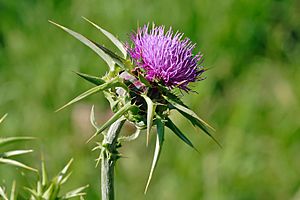
Each of the four parts of the United Kingdom has one or more national flowers:
- England – Tudor rose
- Wales – daffodil, leek
- Northern Ireland – flax flower, clover leaf
- Scotland – thistle, Scots pine
Ukraine
The national flowers of Ukraine are the sunflower and the guelder rose.
North America
Canada
The maple leaf is a very well-known symbol for Canada. The maple tree was officially named Canada's tree symbol in 1996.
Canada's provinces and territories also have their own official floral emblems:
- Ontario: white trillium (Trillium grandiflorum), chosen in 1937.
- Quebec: blue flag (Iris versicolor), chosen in 1999.
- Nova Scotia: mayflower (Epigea repens), chosen in 1901.
- New Brunswick: purple violet (Viola cucullata), chosen in 1936.
- Manitoba: prairie crocus (Pulsatilla ludoviciana), chosen in 1906.
- British Columbia: Pacific dogwood (Cornus nuttallii), chosen in 1956.
- Prince Edward Island: lady's slipper (Cypripedium acaule), an orchid, chosen in 1947.
- Saskatchewan: western red lily (Lilium philadelphicum var. andinum), chosen in 1941.
- Alberta: wild rose (Rosa acicularis), also called the prickly rose, chosen in 1930.
- Newfoundland and Labrador: northern pitcher plant (Sarracenia purpurea), chosen in 1954.
- Northwest Territories: mountain avens (Dryas octopetala), chosen in 1957.
- Yukon: fireweed (Epilobium angustifolium), chosen in 1957.
- Nunavut: purple saxifrage (Saxifraga oppositifolia), chosen in 2000.
Many Canadian flags and coats-of-arms show floral emblems. For example, the flag of Montreal has four floral emblems.
Mexico
The national flower of Mexico is the dahlia (Dahlia pinnata).
United States
In 1986, President Ronald Reagan signed a law making the rose the national floral emblem of the United States. Each of the U.S. states also has its own state flowers and trees.
Central America and the Caribbean
Antigua and Barbuda
The national flower of Antigua and Barbuda is Agave karatto, also known as "dagger log."
The Bahamas
The national flower of the Bahamas is the Yellow Elder (Tecoma stans).
Barbados
The national flower of Barbados is known locally as the Pride of Barbados (Caesalpinia pulcherrima).
Belize
The national flower of Belize is the black orchid (Prosthechea cochleata).
Costa Rica
The national flower of Costa Rica is the guaria morada (Guarianthe skinneri).
Cuba
The national flower of Cuba since 1936 is the white ginger lily.
Dominica
The national flower of Dominica is Sabinea carinalis, also called Carib wood.
Dominican Republic
The Dominican Republic's national flower used to be the mahogany tree flower. In 2011, the mahogany became the national tree. This made room for the Bayahibe rose (Pereskia quisqueyana) to become the national flower. This change helped bring attention to protecting the Bayahibe rose.
Guatemala
The national flower of Guatemala is the monja blanca (Lycaste skinneri var. alba).
Haiti

The national flower of Haiti is the Choeblack or rose kayenn (Hibiscus).
Honduras
The national flower of Honduras is the orchid Rhyncholaelia digbyana.
Jamaica
The national flower of Jamaica is the lignum vitae (Guaiacum officinale).
Nicaragua

The national flower of Nicaragua is the sacuanjoche (plumeria rubra). This flower grows on a tree that blooms around May. Sacuanjoche flowers smell strongest at night to attract moths for pollination.
Oceania
Australia
The Golden Wattle (Acacia pycnantha) was officially named the floral emblem of Australia on September 1, 1988.
French Polynesia
The Tahitian gardenia (tiare flower) is the national flower of Tahiti, French Polynesia, and the Cook Islands.
Fiji
The national flower of Fiji is tagimaucia (Medinilla waterhousei). This vine has red and white flowers and grows only in the highlands of Taveuni island.
New Zealand
New Zealand does not have an official national flower. However, the silver fern (a type of leaf) is recognized as a national symbol. The Kōwhai (Sophora species, native trees with yellow flowers) is usually seen as the national flower.
Tonga
The heilala (Garcinia sessilis) is Tonga's national flower. Many things in Tonga, like festivals and products, are named after this flower. It is also used for medicine and decoration.
South America
Argentina
The national flower of Argentina is the flower of the ceibo tree (Erythrina crista-galli). It is also known as seibo or bucaré.
Bolivia
Bolivia has two national flowers: the kantuta (Cantua buxifolia) and patujú (Heliconia rostrata).
Brazil
The national flower of Brazil is the flower of the golden trumpet tree (Handroanthus albus).
Chile
The national flower of Chile is the copihue (Lapageria rosea).
Colombia
Cattleya trianae is the national flower of Colombia. This orchid blooms in May. It was chosen because its colors are the same as the Colombian flag.
Guyana
The national flower of Guyana is the Victoria regia lily (Victoria amazonica).
Peru
The national flower of Peru is the cantuta (also spelled kantuta or qantuta). It grows in the high valleys of the Andes mountains in Peru and Bolivia.
Paraguay
The national flower of Paraguay is Mburucuyá.
Suriname
The jungle geranium (Ixora coccinea) is often seen as a symbol of Suriname. It is called faya lobi ("fiery love") in Sranantongo.
Uruguay
The national flower of Uruguay is the flower of the ceibo tree (Erythrina crista-galli).
Venezuela
The national flower of Venezuela is the Flor de Mayo (Cattleya mossiae), which is an orchid.
Subnational Plants
Sometimes, plants are chosen to represent smaller areas within a country, like states, provinces, or counties.
Australia
Each Australian state and territory has its own floral emblem:
- Australian Capital Territory – Royal Bluebell (Wahlenbergia gloriosa)
- New South Wales – New South Wales Waratah (Telopea speciosissima)
- Northern Territory – Sturt's Desert Rose (Gossypium sturtianum)
- Queensland – Cooktown Orchid (Dendrobium phalaenopsis)
- South Australia – Sturt's Desert Pea (Swainsona formosa)
- Tasmania – Tasmanian Blue Gum (Eucalyptus globulus)
- Victoria – Pink (Common) Heath (Epacris impressa)
- Western Australia – Red and Green Kangaroo Paw (Anigozanthos manglesii)
Norway
- Lily-of-the-valley was chosen as the county flower of Østfold.
- Globe flower is the county flower of Troms.
United Kingdom
Each of the four countries in the United Kingdom has a traditional floral emblem:
- England – officially the Tudor rose or unofficially the red rose.
- Northern Ireland – the flax, orange lily, or shamrock.
- Scotland – the Scotch thistle.
- Wales – the daffodil or leek.
County Flowers
A county flower is a flowering plant chosen to symbolize a county. These are mostly found in the United Kingdom.
Some county flowers in England have a long history, like the red rose of Lancashire from the Middle Ages. But the idea of having a flower for every county across the UK became popular in 2002. This was part of a competition run by a charity called Plantlife to celebrate Queen Elizabeth II's Golden Jubilee.
Plantlife's plan used Britain's historic counties. So, some areas today might not have a flower, and some old counties that no longer exist as official areas do have one. Flowers were also chosen for thirteen major cities.
A total of 94 flowers were chosen in the competition. Most counties have a unique flower. However, some flowers were chosen by more than one county. For example, Foxglove was chosen for four counties.
Most of the chosen county flowers are plants that grow naturally in those areas.
Unofficial Plants
Some countries do not have an official national flower, but certain plants are still seen as important symbols.
Armenia
Armenia does not have an official national flower. Some flowers from the area include Althaea armeniaca, Armenian Basket, Muscari armeniacum, Armenian Poppy, and Tulipa armena.
Azerbaijan
Azerbaijan does not have an official national flower. However, the city of Shusha named the Khari Bulbul (Ophrys caucasica) as its floral emblem.
Belarus
The unofficial national flower of Belarus is the wild blue flax, Centaurea.
China
China currently has no official national flower. Different regions have their own symbols.
In 1903, the Qing dynasty named the peony (牡丹) the national flower. The peony has long been a symbol of wealth and honor in China.
The plum blossom, meihua (Chinese: 梅花; pinyin: méihuā), is also a very loved flower in Chinese culture. It stands for strength and never giving up, because it blooms even in harsh winter snow.
The People's Republic of China, which has controlled mainland China since 1949, does not have an official floral emblem. There have been talks about choosing one. Some people want the peony, while others prefer the plum blossom.
Ecuador
No flower has been officially named a national symbol in Ecuador. Unofficially, the rose and the orchid are often considered national flowers.
Egypt
Both Blue Egyptian Lotus and White Egyptian Lotus are seen as Egypt's national flowers. They appear in many Ancient Egyptian paintings and monuments.
Guinea
In a 2018 public vote, Vernonia djalonensis was chosen as the national flower of Guinea. This decision is waiting for government approval.
Italy
Italy does not have an official floral emblem. However, the lily is often mentioned. The Rose and the White poppy are also sometimes suggested.
Japan
Japan's government has never officially named a national flower. However, the sakura (cherry blossom) is widely seen as a national flower for Japan. A special design of a Chrysanthemum morifolium is used as the official symbol of the imperial family.
France
While France does not have an official national flower, the fleur-de-lis was a symbol of the royal family. Also, the cornflower (blue), marguerite (white), and red poppy are often seen as French national flowers. Together, their colors match the national flag.
Vietnam
Vietnam does not have an official flower. However, four plants are traditionally seen as the four graceful plants: the lotus, the pine, bamboo, and the chrysanthemum. The lotus (Nelumbo nucifera) is generally considered the unofficial national flower of Vietnam. In Vietnamese tradition, the lotus stands for "purity, commitment, and hope for the future."
Images for kids
-
Darius the great holds a water lily In Persepolis


